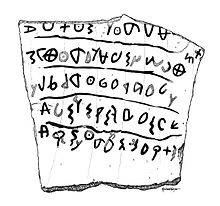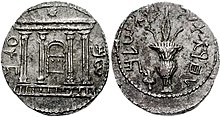Paleo-Hebrew alphabet
| Paleo-Hebrew | |
|---|---|
 | |
| Script type | |
Time period | c. 1000 BCE – 135 CE |
| Direction | right-to-left script |
| Language | Biblical Hebrew |
| Related scripts | |
Parent systems | |
Child systems |
|
Sister systems | |
| ISO 15924 | |
| ISO 15924 | Phnx, , Phoenician |
| Unicode | |
Unicode alias | Phoenician |
Unicode range | U+10900–U+1091F |
The Paleo-Hebrew script (Hebrew: הכתב העברי הקדום), also Palaeo-Hebrew, Proto-Hebrew or Old Hebrew, is the writing system found in Canaanite inscriptions from the region of Biblical Israel and Judah. It is considered to be the script used to record the original texts of the Hebrew Bible due to its similarity to the Samaritan script, as the Talmud stated that the Hebrew ancient script was still used by the Samaritans.[1] The Talmud described it as the "Libona’a script" (Hebrew: ליבונאה), translated by some as "Lebanon script".[2] Use of the term "Paleo-Hebrew alphabet" is due to a 1954 suggestion by Solomon Birnbaum, who argued that "[t]o apply the term Phoenician to the script of the Hebrews is hardly suitable".[3]
The first Paleo-Hebrew inscription identified in modern times was the Shebna inscription, found in 1870, and then referred to as "two large ancient Hebrew inscriptions in Phoenician letters".[4][5] Fewer than 2,000 inscriptions are known today, of which the vast majority comprise just a single letter or word.[6][7] The earliest known examples of Paleo-Hebrew writing date to the 10th century BCE.[8][9][10]
Like the Phoenician alphabet, it is a slight regional variant and an immediate continuation of the Proto-Canaanite script, which was used throughout Canaan in the Late Bronze Age.[11] Phoenician, Hebrew, and all of their sister Canaanite languages were largely indistinguishable dialects before that time.[12][13] The Paleo-Hebrew script is an abjad of 22 consonantal letters, exactly as the other Canaanite scripts from the period.
By the 5th century BCE, among Judeans the alphabet had been mostly replaced by the Aramaic alphabet as officially used in the Persian empire (which, like all alphabetical writing systems, was itself ultimately a descendant of the Proto-Canaanite script, though through intermediary non-Israelite stages of evolution)[citation needed]. The "Jewish square-script" variant now known simply as the Hebrew alphabet evolved directly out of the Aramaic script by about the 3rd century BCE (although some letter shapes did not become standard until the 1st century CE). By contrast, the Samaritan alphabet, as used by Samaritans, is an immediate continuation of the Proto-Hebrew script without intermediate non-Israelite evolutionary stages[citation needed]. There is also some continued use of the old Hebrew script in Jewish religious contexts down to the 1st century BCE, notably in the Paleo-Leviticus text found in the Dead Sea scrolls.[citation needed]
History[]
Origins[]


The Paleo-Hebrew and Phoenician alphabets developed in the wake of the Bronze Age collapse, out of their immediate predecessor script Proto-Canaanite (Late Proto-Sinaitic) during the 13th to 12th centuries BCE, and earlier Proto-Sinaitic scripts.
The earliest known inscription in the Paleo-Hebrew script is the Zayit Stone discovered on a wall at Tel Zayit, in the Beth Guvrin Valley in the lowlands of ancient Judea in 2005, about 50 km (31 mi) southwest of Jerusalem. The 22 letters were carved on one side of the 38 lb (17 kg) stone, which resembles a bowl on the other. The find is attributed to the mid-10th century BCE. The so-called Ophel inscription is of a similar age, but difficult to interpret, and may be classified as either Proto-Canaanite or as Paleo-Hebrew. The Gezer calendar is of uncertain date, but may also still date to the 10th century BCE.
The script on the Zayit Stone and Gezer Calendar are an earlier form than the classical Paleo-Hebrew of the 8th century and later; this early script is almost identical to the early Phoenician script on the 9th-century Ahiram sarcophagus inscription. By the 8th century, a number of regional characteristics begin to separate the script into a number of national alphabets, including the Israelite (Israel and Judah), Moabite (Moab and Ammon), Edomite, Phoenician and Old Aramaic scripts.
Linguistic features of the Moabite language (rather than generic Northwest Semitic) are visible in the Mesha Stele inscription, commissioned around 840 BCE by King Mesha of Moab. Similarly, the Tel Dan Stele, dated approximately 810 BCE, is written in Old Aramaic, dating from a period when Dan had already fallen into the orbit of Damascus.

The oldest inscriptions identifiable as Biblical Hebrew have long been limited to the 8th century BCE. In 2008, however, a potsherd (ostracon) bearing an inscription was excavated at Khirbet Qeiyafa which has since been interpreted as representing a recognizably Hebrew inscription dated to as early as the 10th century BCE. The argument identifying the text as Hebrew relies on the use of vocabulary.[14]
From the 8th century onward, Hebrew epigraphy becomes more common, showing the gradual spread of literacy among the people of the Kingdom of Israel and the Kingdom of Judah; the oldest portions of the Hebrew Bible, although transmitted via the recension of the Second Temple period, are also dated to the 8th century BCE.
Use in the Israelite kingdoms[]

The Paleo-Hebrew alphabet was in common use in the kingdoms of Israel and Judah throughout the 8th and 7th centuries BCE. During the 6th century BCE, the time of the Babylonian exile, the Paleo-Hebrew alphabet was gradually replaced by the use of the Imperial Aramaic alphabet. The letters of Imperial Aramaic were again given shapes characteristic for writing Hebrew during the Second Temple period, developing into the "square shape" of the Hebrew alphabet.[15]
The Samaritans, who remained in the Land of Israel, continued to use their variant of the Paleo-Hebrew alphabet, called the Samaritan script.[16] After the fall of the Persian Empire, Jews used both scripts before settling on the Assyrian form.
The Paleo-Hebrew script evolved by developing numerous cursive features, the lapidary features of the Phoenician alphabet being ever less pronounced with the passage of time. The aversion of the lapidary script may indicate that the custom of erecting stelae by the kings and offering votive inscriptions to the deity was not widespread in Israel. Even the engraved inscriptions from the 8th century exhibit elements of the cursive style, such as the shading, which is a natural feature of pen-and-ink writing. Examples of such inscriptions include the Siloam inscription,[17] numerous tomb inscriptions from Jerusalem,[18][19] the Ketef Hinnom scrolls, a fragmentary Hebrew inscription on an ivory which was taken as war spoils (probably from Samaria) to Nimrud, the Arad ostraca dating to the 6th-century BCE, the hundreds of 8th to 6th-century Hebrew seals from various sites, and the Paleo-Hebrew Leviticus scroll discovered near Tel Qumran. The most developed cursive script is found on the 18 Lachish ostraca,[20] letters sent by an officer to the governor of Lachish just before the destruction of the First Temple in 586 BCE. A slightly earlier (circa 620 BCE) but similar script is found on an ostracon excavated at Mesad Hashavyahu, containing a petition for redress of grievances (an appeal by a field worker to the fortress's governor regarding the confiscation of his cloak, which the writer considers to have been unjust).[21][22]
Decline and late survival[]

